Chapter 3 Plant Kingdom
Class 11th Biology NCERT Book Solution
NCERT Solutions For Class 11 Biology Plant Kingdom
NCERT TEXTBOOK QUESTIONS SOLVED
1.What is the basis of
classification of algae?
soln. Fritsch (1935), has
classified algae considering phylogeny, affinities and inter-relationships of
various forms. He classified algae mainly on the basis of the characters like
structure of plant body, nature of the pigments, reserve food material, number
and position of flagella, chemistry of cell wall and methods of reproduction
etc. Algae is divided into 11 classes but among them 3 main classes are
Chlorophyceae, Phaeophyceae and Rhodophyceae.
2.When and where does
reduction division take place in the life cycle of a liverwort, a moss, a fern,
a gymnosperm and an angiosperm?
soln.All
of these plants show life cycle with one gametophytic (n) generation and one
sporophytic (2n) generation. Reduction division or meiosis that produces haploid
(n) cells from diploid cells (2n) is necessary in their life cycles to restore
gametophyte generation after sporophytic generation. It occurs in different body
structures according to the basic body design of these groups. Reduction
division in a liverwort and moss takes place at the end of the sporophytic
generation, where haploid spores are formed by reduction division of spore
mother cell inside capsule. Spores germinate to produce dominant gametophytic
generation. Reduction division in fern takes place at the end of the dominant
sporophytic generation inside the sporangium from spore mother cell by reduction
division. Spores may be of one type (homospory) or of two types
(heterospory).
Reduction division in gymnosperms takes place at the end of
dominant sporophytic generation. Megaspore and microspores are produced by the
reduction division of diploid megaspore mother cell and diploid microspore
mother cell respectively, inside megasporangium and microsporangium. Reduction
division in angiosperms takes place at the end of dominant sporophytic
generation. The haploid pollen grain or microspore and the haploid egg cell are
produced by the reduction division of diploid (microspore) mother cell and
diploid megaspore mother cell respectively. Microsporic division occurs inside
anther and megasporic division occurs inside gynoecium (ovary).
More Resources for CBSE Class 11
3.Name three groups of plants
that bear archegonia. Briefly describe the life cycle of any one of
them.
soln. The three groups of
plants that bear archegonia are bryophytes, pteridophytes and gymnosperms.
Life cycle of a bryophyte is as follows : The main plant body of bryophyte is
gametophytic (n), which is independent and may be thallose (no differentiation
in root, stem, leaves) e.g., Riccia, or may be foliose (having leafy axis) e.g.,
Funaria. The dominant phase in the life cycle of Funaria is the gametophyte,
which occurs in two stages, the protonema stage and the erect, leafy
gametophytic plant.
The leafy gametophyte consists of an upright, slender
axis (stem-like) that bears spirally arranged leaves and is attached to the
substratum by multicellular, branched rhizoids. Vegetative reproduction takes
place
by fragmentation; by the buds formed in secondary protonema etc. The
sex organs, antheridia and archegonia are produced in dusters at the apices of
the leafy shoots. Antheridia produces antherozoids and archegonia produces egg.
Antherozoid (male gamete) and egg (female gamete) fuses and form zygote.Zygote
develops into a sporophyte; which is differentiated into foot, seta and capsule
and spores are produced in the capsule.
Spores on reaching a suitable
substratum germinate to produce a filamentous juvenile stage, .called the
primary protonema, which later produces secondary protonema that forms erect
leafy plants.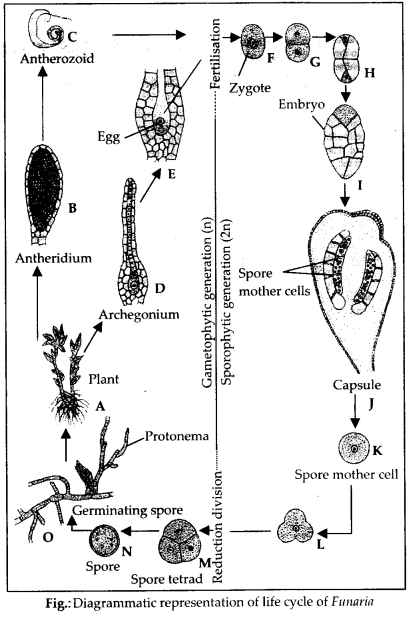
4.Mentiontheploidyofthefollowingrprotonemal
cell of a moss; primary endosperm nucleus in dicot, leaf cell of a moss;
prothallus cell of a fern; gemma cell in Marchantia; meristem cell of monocot,
ovum of a liverwort, and zygote of a fern.
soln.
Protonemal cell of a moss – haploid. Primary endosperm nucleus in dicot –
triploid.
Leaf cell of a moss – haploid.
Prothallus cell of a fern –
haploid.
Gemma cell in Marchantia – haploid. Meristem cell of monocot –
diploid.
Ovum of a liverwort – haploid.
Zygote of a fern – diploid.
5.Write a note on economic
importance of algae and gymnosperms.
soln.
Economic importance of algae is as follows:
The group Algae plays both
economically beneficial as well as harmful roles.
Beneficial importance :
(i) People of coastal countries have been using sea weeds & certain other
algae as source of food, e.g., Porphyra, Ulva, Laminaria, etc.
(ii)Some algae
are used as food for marine as well as domestic animals, e.g., Sargassum,
Macrocystis.
(iii)Algae are useful source of many commercial products like
agar, a jelly like substance (complex polysaccharide) is extracted form species
of red algae belonging to the genera Gelidium, Gracilaria etc. Agar is also used
as base in culture media. Carrageenin occurs as a cell wall polysaccharide,
esterified with sulphate. It is extracted from red alga like Chondrus Crispin,
etc. is used in pharmaceutical emulsifier and textile, leather, cosmetic
industries. Alginates are salts of alginic acid found in the cell wall of
phaeophyceae (brown algae) like Fucus, Laminaria etc.
(iv)Algae are also
useful in medicine industry. Antibiotic chlorellin is obtained from Chlorella.
Extracts of Cladophora, Lyngbya kill strains of Pseudomonas and Mycobacterium
like bacteria. Nitella is used to destroy mosquitoes growth in ponds and hence
used in control of malaria.
(v) Some algae are used in agriculture like
Nostoc, Anabaena etc. are used to convert atmospheric N2 into nitrogenous
compounds which are absorbed by higher plants. Some sea weeds like Fucus,
Litlwphyllum, Lycophyllum etc. are rich io K, P, trace elements and growth
substances and are used as fertilisers by coastal people.
(vi)Some algae like
Chlorella, Chlamydomonas, etc. are used in sewage disposal in ponds. These algae
help in bacterial decomposition by providing 02.
(vii)Some algae like
Chlorella, Synecoccus, etc are used in space travels. A person inside a
spaceship will need a device to get rid of C02 and other body wastes and will
require sources of Oz and food. These algae are very useful for this
purpose.
(viii)A large amount of iodine (mineral element present in thyroxine
hormone of thyroid gland) is extracted from kelps (brown sea weeds or members of
phaeophyceae) like Laminaria, Fucus, Ascophyllum etc. Similarly red algae like
Rhodomela, Polysiphonia, Rhodymenia are sources of bromine.
Harmful
importance:
(i) Some blue green and green algae like Chroococcus,
Oscillatoria grow over the surface of water bodies in abundance and cause water
bloom. On death and decay these algae give off bad smell. Some algae secrete
poisonous or toxic substances.
(ii)Parasitic algae like Cephaleuros virescens
causes red rust of tea, coffee etc.
Economic importance of gymnosperms is as
follows:
(i)Some species of Cycas like C. revoluta, C. rumphii look like palm
tree and are used for decoration purposes as they remain fresh for long
period.
(ii)Stem portion of Cycas revoluta is a good source of ‘sago’, a kind
of starch used in making bread by poor people. Seeds of some species of Cycas
are roasted and taken as food. Young succulent leaves of some species of Cycas
are cooked as vegetable.
(iii)Many gymnospersm have medicinal value. The
fresh juice extracted from the Cycas circinalis leaves is used as medicine for
stomach disorders, blood vomiting and other skin diseases. Pollen grains of some
Cycas plants are reported to have some narcotic effect.
(iv)Some gymnosperms
like Pinus, Abies, Cedrus are the chief source of various types of woods. The
wood of Juniperus is used in making pencils, scales, holders etc.
(v)Some
species of Pinus is a good source of turpentine, wood gas, wood alcohol.
6.Both gymnosperms and
angiosperms bear seeds, then why are they classified
separately?
soln.’Gymnosperms and
angiosperms both bear seeds but they are classified separately because
gymnosperms are a group of plants in which the ovules are freely exposed on open
megasporophylls, whereas in angiosperms the seeds or ovules are enclosed within
ovary which later forms the fruit.
7.What is heterospory?
Briefly comment on its significance. Give two examples.
soln. The occurrence of
two kinds of spores in the same plant is called as heterospory. Among them the
smaller spore is called microspore and the larger spore is called megaspore.
Heterospory first evolved in pteridophytes. Significance of heterospory
(i)
Heterospory is associated with the sexual differentiation of gametophyte
/.<?., a microspore develops into a male gametophyte whereas a megaspore
develops into a female gametophyte.
(ii)In homosporous pteridophytes spores
have to germinate on soil thus face more environmental problems. In
heterosporous pteridophytes, spores germinate within the sporangium and the
gametophytes are retained inside for variable periods of time. Hence,
germinating gametophyte has better chances of survival. This lays the foundation
of complete retention of gametophytes within sporophytes in angiosperms and
gymnosperms.
(iii)Heterospory is the basis of development of seed habit in
higher plants.
8.Explain briefly
thefollowing terms with suitable examples.
(i) Protonema (ii) Antheridium
(iii)Archegonium (iv) Diplontic (v) Sporophyll (vi)
Isogamy
soln. (i) Protonema : It
is the first, usually branched, green and filamentous structure produced by a
germinating moss or fern spore. The protonema of mosses bears buds that develop
into the gametophyte plant. In fern the protonema becomes the prothallus.
(ii)Antheridium : The male sex organ of cryptogams (algae, fungi, bryophytes
and
pteridophytes) is known as antheridium. It produces the male gametes or
anthero- zoids. It may consist of a single cell or it may have a wall that is
made up of one or several layers forming a sterile jacket around the developing
gametes.
(iii)Archegonium : The multicellular flask shaped female sex organ
of bryophytes, pteridophytes and many gymnosperms is known as archegonium. Its
dialated base called the venter contains the female gamete or egg or oosphere.
The cells of the narrow neck of archegonium liquify to allow the male gametes to
swim towards the oosphere.
(iv)Diplontic : It is the kind of life cycle in
which the diploid sporophyte is dominant and this diploid phase is
photosynthetic. The gametophytic phase is represented either by gametes only,
that are formed through meiosis or by a highly reduced few celled gametophyte.
E.g., all seed-bearing plants (gymnosperms and angiosperms).
(v) Sporophyll :
It is a type of leaf bearing sporangia. In ferns, the sporophylls are the normal
foliage leaves, but in other plants the sporophylls are modified and arise in
specialised structure such as the strobili of club-moss, gymnosperms and the
flower of angiosperms. In most plants sporophylls are of two types –
microsporophylls and megasporophylls.
(vi)Isogamy: It is a type of sexual
reproduction where fusion takes place between two identical gametes. The gametes
are similar in size and structure and they show equal motility during sexual
reproduction, e.g., Spirogyra (algae).
9.Differentiate between the
following:
(i) Red algae and brown algae
(ii)Homosporous and heterosporous pteridophytes
(iii)Liverworts and moss
(iv)Syngamy and triple fusion.
soln.(i)
The differences between red algae and brown algae are as follows :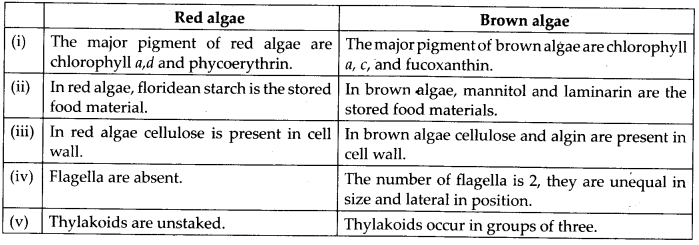
(ii) The differences between homosporous and heterosporous
pteridophytes are as follows: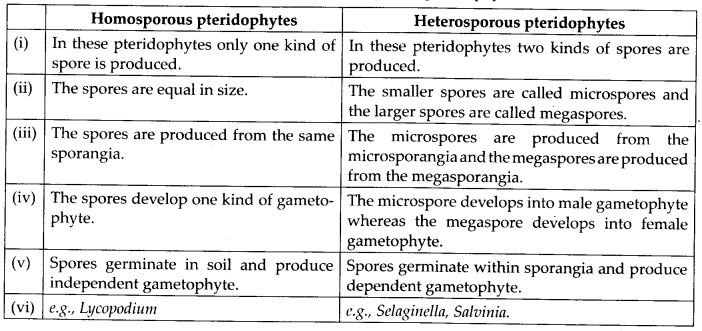
(iii) The differences between liverworts and mosses are as
follows :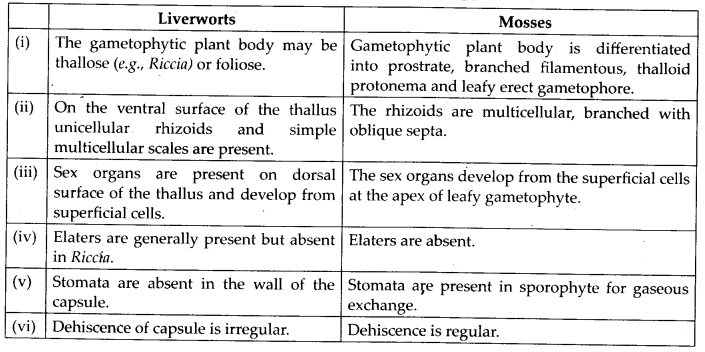
(iv) The differences between syngamy and triple fusion are as
follows :
10.How would you distinguish
monocots from dicots?
Soln.
Differences between monocots and dicots are as follows :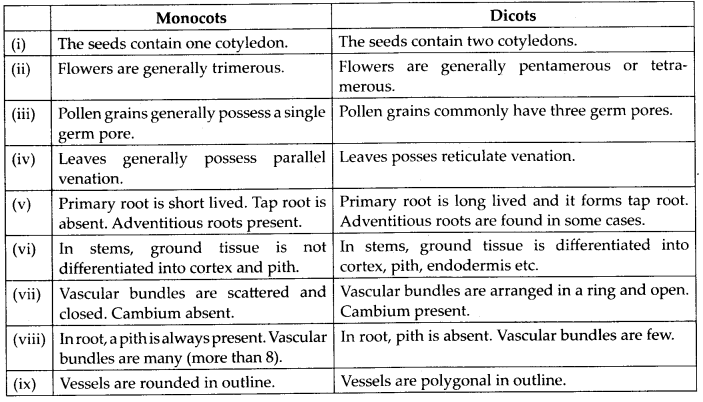
11.Match the following
(Column I with Column II).
Column I
Column
II
(a)Chlamydomonas
(i)Moss
(b)Cycas
(ii)Pteridophyte
(c) Selagmella
(iii)Algae
(d) Sphagnum
(iv)Gymnosperm
Soln.
Chlamydomonas – Algae
Cycas
–
Gymnosperm
Selayinella
– Pteridophyte
Sphagnum
– Moss
12.Describe
the important characteristics of gymnosperms.
Soln.The
term gymnosperm is derived from two Greek words: Gymnos = naked + Sperma = seed,
i.e., naked seeded plants. So gymnosperms are a group of plants inwhich the
ovules are freely exposed on open megasporophylls. The important characteristics
of gymnosperms are :
– Living gymnosperms are perennial and vary from
predominantly medium – sized trees (Cycas) to tall trees (Pinus) and shrubs
(Ephedra).
– Plants possess tap root system. Some genera possess symbiotic
relationship of N2 fixing algae in coralloid roots (Cycas) and fungi in
mycorrhizal roots (Pinus).
– The stems are aerial, erect, branched
(unbranched in Cycas) and woody.
– The leaves may be simple or compound. They
are scaly and foliage also. Leaves are well adapted to withstand extremes of
temperature, humidity and wind.
-Roots are characterised by the presence of
diarch to polyarch vascular bundles. Xylem is exarch.
-Stems are provided
with collateral, endarch and open vascular bundles which are arranged in a ring.
Secondary growth is present and annual rings are formed.
-Xylem contains
xylem parenchyma and tracheids with bordered pits and vessels are absent (except
in Gnetum; Ephedra and Wehmtschia).
-Phloem contains sieve cells and phloem
parenchyma and companion cells are absent (except in Gnetum; Ephedra and
Weluhtschia).
-Leaves are protected by thick layers of cuticle. Sunken
stomata are present. Mesarch xylem and transfusion tissues are found in the
leaves. Palisade tissue and spongy parenchyma may be present in mesophyll or it
may be undifferentiated.
-The reproductive organs form cones or strobilus
except female organs of Cycas.
-The male cone is made of overlapping
microsprophylls, that bear micros¬porangia on the abaxial side which produce
microspores.
-Female cone is formed by overlapping megasporophylls which bear
ovules (megasporangia).
-Ovule is orthotropous, unitegmic with 3 layers i.e.
outer fleshy, middle stony and inner fleshy.
– The nucellus of ovule contains
single megaspore mother cell which undergoes reduction division to form 4
megaspores, out of which 3 degenerate and only one survives.
– So gymnosperm
is heterosporous i.e. producing microspores and megaspores.
– Single
megaspore forms haploid female
gametophyte or endosperm before fertilisation.
.
– At micropylar end of female gametophyte 2 or more archegonia are
produced. Archegonium is with reduced neck (with no neck canal cell).
–
Microspores are released from microsporangium and are carried in air currents
and come in contact with the micropyle of the ovules.
– Pollen tube carrying
the male gametes grows towards archegonia and discharges its contents near the
mouth of the archegonia.
– After fertilisation zygote or oospore gives rise
to embryo proper and the ovules develop into seeds.
– Polyembryony i.e.,
development of more than one embryo is an usual feature of gymnosperms but only
one of them survives at later stage.
– In embryo 2 or many cotyledons are
present.
– The seeds of gymnosperms are uncovered.